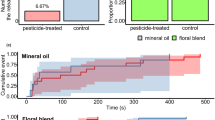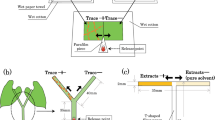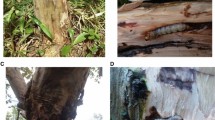Abstract
Exploitation of commodities exchanged in mutualistic interactions has been broadly documented, but typically involve the exploitation of a reward rather than a service. Further, examples of exploiter species are extremely rare in certain groups of animals, such as spiders. In 2008 and 2009, we investigated the potential exploitation by an orb-weaving spider (Eustala oblonga) of the plant protection services of ants on an ant-defended acacia (Acacia melanocerus) in lowland rainforest in central Panama. Despite vigorous patrolling of the acacias by the very pugnacious ants (Pseudomyrmex satanicus), we observed the spiders constructing orb webs among the branches at night and resting quietly during the day on the leaves or at the bases of the thorns in which the ants live and raise their brood. E. oblonga spiders occurred in fairly high densities on A. melanocerus, but were very rarely observed on A. melanocerus plants that were no longer occupied by P. satanicus or on other species of plants in the forest understory. Further, the spiders were never observed attacking the ants. To test the hypothesis that E. oblonga inhabits the ant-defended acacias for protection against would-be spider predators, we removed entire ant colonies from acacias by injecting tiny amounts of a dilute insecticide into all hollow thorns serving as domatia for the ants, killing the ants within 30 minutes. We then compared spider abundance for six weeks on the acacias without ant colonies to spider abundance on acacias with intact colonies of defending ants. During the weekly ant censuses, we also recorded the presence and abundance of any other invertebrate or vertebrate species on the experimental and control acacias, particularly noting any potential predators of the spiders. Spider abundance did not vary between the experimental and control plants during the first two weeks after the initiation of the experiment, but then decreased significantly on the acacias without ant colonies over the remaining four weeks of sampling. This decrease in spider abundance is not likely to be attributed to application of the dilute insecticide because spiders were not immediately affected and the insecticide degrades within 24 hours of application. Other organisms increased in abundance over time on the experimental acacias relative to the control acacias, including predatory insects and other potential spider predators. These results suggest that ant protection of A. melanocerus also protects the spiders, thus, supporting the hypothesis that E. oblonga exploits the ant-acacia mutualism for enemy-free space.
Similar content being viewed by others
Article PDF
Author information
Authors and Affiliations
Corresponding author
Rights and permissions
About this article
Cite this article
Styrsky, J. Living dangerously: an orb-weaving spider potentially exploits an ant-acacia mutualism for enemy-free space. Nat Prec (2010). https://doi.org/10.1038/npre.2010.5196.1
Received:
Accepted:
Published:
DOI: https://doi.org/10.1038/npre.2010.5196.1



